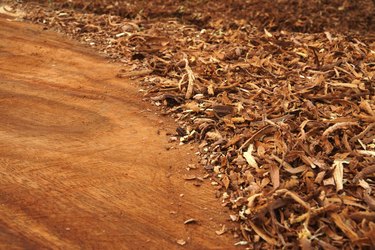
If you've ever worked with wood, you're familiar with this scenario: You're about to apply the finish to a piece when you come across gouges that will remain noticeable if you don't fill them -- and you're out of filler. Not to worry, because you can make your own, and it will probably match more closely than a store-bought one. You can also make your own wood putty and bulk filler for painted projects.
Hang On to That Sawdust!
Video of the Day
The sawdust left over from sanding is the raw ingredient for a wood filler more durable than the wood itself and capable of taking stain. When you're sanding, it's always a good idea to collect some sawdust and save it in a jar or paper cup -- particularly when you're working with exotic wood. The sawdust that collects under your table saw when you're cutting wood is also useful, but it's too coarse to use as a filler until you grind it with a coffee grinder. For the best color-matching results, avoid mixing different types of sawdust in the same container.
Video of the Day
Mix Sawdust With Glue
The other ingredient in a homemade sawdust wood filler is something to hold it together. Before mixing the sawdust with carpenter's glue, remember that this water-soluble product has a color of its own and gives the filler an unappealing grayish tinge. Clear epoxy glue is a better choice, especially if you need to mold the filler around the edge of a piece of wood. It's also suitable for filling cracks and gouges in flat wood that you plan to clear-coat. Whether you use wood or epoxy glue, you have a window of opportunity of only minutes to use the filler before it hardens.
Lacquer-Based Filler
Mixing sawdust with nitrocellulose lacquer makes a resilient, durable filler that you can use for small projects as well as large ones, such as filling gaps in wood flooring. Grind the sawdust you plan to use in a coffee grinder and add it to a small amount of lacquer that you've already poured into a bowl. Lacquer faithfully preserves the color of the sawdust and is easier to sand than glue. It dries more quickly than wood glue, but you can always soften it by adding more lacquer or a small amount of lacquer thinner.
Homemade Painter's Putty
When you need to fill multiple cracks and gouges on a large surface before painting, you can make an economical filler with limestone, calcium carbonate -- which is basically chalk -- and linseed oil. They are the three main ingredients in most brands of painter's putty. Pour the oil in a bowl and add lime and calcium carbonate incrementally in equal parts -- stirring as you do -- until you have a putty with the consistency you need for the job. If you're filling a painted surface, add colorant to match the color of the putty to that of the paint; the colorant in store-bought white putty is titanium dioxide. This filler is waterproof and remains flexible enough to move with the wood under changing conditions, making it a good choice for exterior applications.